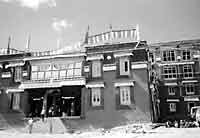|
|
||||
|
Fundraising in progress to provide comprehensive water system to a Tibetan village |
||||
|
by Sharon Dawson Gangchen Village is situated 20 miles from Shigatse, Central Tibet. The village has a population of around 400, with a further 1300 people living in the nearby villages of Ney Dakshu, Singma and Ragku. The inhabitants of these villages live principally by subsistence farming, but in this arid area of Tibet the weather conditions combined with the altitude (4000 meters) put a continuous strain on the farmers, often impeding them from producing enough food to live on. The entire area is deprived of power supplies, palatable water and until recently, was also without primary healthcare and educational structures. Gangchen Village Project was formally initiated in 1998 by Lama Gangchen, with the decision to rebuild the local Monastery - the heart of every Tibetan community. However, to improve the quality of life for these people, the completed project also forsees the creation of educational and healthcare facilities in the entire area, the supply of electrical and solar power, and the provision of a system which will transport to the villages the very precious element of water. Resume 1999 Gangchen Monastery: The monastery was originally founded in the XVth century by Panchen Zangpo Tashi - one of Lama Gangchen's previous incarnations - who was the chosen disciple of the Ist Dalai Lama, Panchen Gedun Drup. Until 1959, when it was destroyed, monastic life in Gangchen was prosperous with over 350 monks living in the monastery. Generous donations from western friends allowed the rebuilding work to begin immediately and with the help and dedication of the local people, monks from Tashi Lumpo Monastery and a team of builders from nearby Shigatse the work progressed at miraculous speed. The four floors of the main structure (realised in stone and wood) are now completed; the external walls and windows are traditionally painted with ornamental designs. Artists have also decorated the interior of the prayer hall with murals illustrating the life of Buddha and tangkhas (sacred paintings on cloth). An enormous statue (two floors high) of Buddha Shakyamuni is also housed in the monastery. Future plans include the replacement of many sacred Buddhist texts, so that the ancient traditions will be preserved through study and practise. The new monastery - the social and religious focal point of Tibetan communtiy - has brought back to life the village of Gangchen and the surrounding area. It is now very near completion and Lama Gangchen is expected to official inaugurate the new building in the year 2000. US $300,000, have so far been collected and used to realise the construction of the monastery. Healthcare: A medical clinic has already been built next to the monastery where a traditional Tibetan doctor is now at work. The clinic was provided this summer with enough medicine to last at least one year. Lama Gangchen has also donated money to realise five smaller dispensaries in the Sakya District (one of the poorest areas of Tibet) as well as giving regular financial support to the clinic of Tashi Lumpo Monastery which treats around 150 patients a day from the surrounding area. In 1999 around US $50,000 have been donated to healthcare projects in Tibet. Sponsorships: Through «Help in Action» there are currently 240 adoptions at a distance in progress. The donations have been used to pay school fees, to buy school materials, clothes, uniforms, food and other necessities. In 1999 almost US $ 20,000 were distributed among the poor and needy families of this area, this figure will increase in the year 2000 as the work of the Association grows. Environmental Care: In an attempt to take care of and develop the environment, a tree planting campaign was carried out last year. With great joy the villagers transported and worked tirelessly to plant over 500 fruit trees. A protective wall was constructed around the trees and the villages water the trees daily. Approximately US $15,000 was spent. Humanitarian Aid: Financial aid has also been extended to a further 10 governmental schools and 8 medical dispensaries in the Sakya district as well as to the recently constructed school in Nye Drakshu. Power Supplies: In a part of Tibet that is completely deprived of electrical power an effective interim solution was the purchase and installation of a number of solar panels. Although these are enough to provide the monastery with the minimum amount of power needed for light - there is not enough power for the clinic or to run a water pump. US $10,000 was used to purchase solar panels, but further funds are needed to bring a more efficient electrical power supply to the area. Year 2000
Housing: In the coming months
(Spring 2000) work is expected to begin on the construction of living
quarters for the monks who presently live in rather precarious and
uncomfortable conditions. The preparation of materials for the building
work is already underway. An estimated |
||||
|
|
||||


